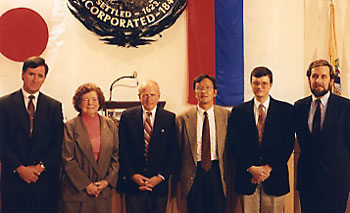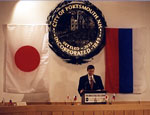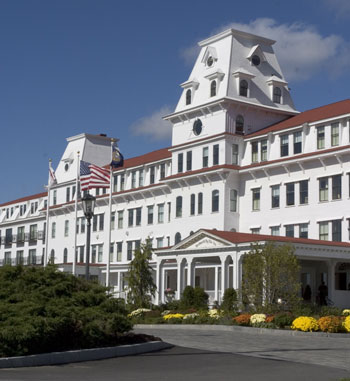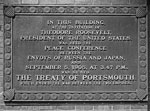 LEGACY
LEGACY

Legacy, Part Three: Treaty Commemorations
The first event commemorating the treaty was held on September 5, 1906, at the Navy Yard when at the same hour when the treaty was signed, a bronze plaque was unveiled. Designated as “Peace Day,” the anniversary was observed with a display of flags and the ringing of bells at sunrise, noon and sunset. At three o’clock, following the hoisting of the three national flags and playing of the three national anthems, the plaque was unveiled by Misses Margaret Edwards and Margaret Parker, daughters of Commanders James R. Edwards and James T. Parker of Portsmouth. [12a] The copper plaque was alloyed with metal pieces of Japanese and Russian origin “so that the event might be perpetuated by the mingled metals.”
Over the years remembrances of the treaty had mainly been observed with historical articles in the Portsmouth Herald. When Wilson came to town he often wrote articles on some aspect of the subject for the paper and when the Piscataqua History Club was formed in the mid1960s, Wilson often scheduled a club meeting at the Wentworth with the conference as the subject. A formal celebration of the anniversary was on September 5, 1980 on the seventy-fifth anniversary of the signing. Japanese Consul-General Takeo Iguchi spoke at a reception at the Portsmouth Public Library at the opening of an exhibit commemorating the treaty. Co-chaired by Herald editor Ray Brighton and city Librarian Dorothy Vaughan, the exhibition was also represented a tribute to Wilson. Through the efforts of Joseph P. Copley and Wilson, a large collection of the photographs, documents, artifacts, and furniture was displayed. The anniversary also marked the publication of a Leon Anderson-Thomas Wilson booklet on the Japanese Fund.
Sister City and Nichinan
The year 1985 marked the beginning of a new local emphasis on the treaty and its relevance to contemporary affairs. In that year, the mayor of Nichinan, birthplace of diplomat Jutaro Komura, wrote to then-Mayor Eileen Foley asking if Portsmouth would become a sister city. Foley and the city council immediately accepted the offer and a delegation led by the mayor of Nichinan came to Portsmouth in August to help celebrate the 80th anniversary of the peace conference.
The Nichinan delegation included not only private citizens but also artisans and musicians who gave demonstrations and performances. A State Street parade of the Nichinan people dressed in traditional clothing was followed by a gala banquet in the former Warehouse Restaurant on Bow Street.
Since 1985 there have been a number of friendship exchanges among residents and home stay programs for junior and senior high school students. Agata Higashi Elementary School and New Franklin Elementary School, and Nichinan Gakuen High School and Portsmouth High School are sister schools and have deepened their relationships through these exchanges, most recently in 2005.
While Nichinan has always revered Komura, the story of that remarkable diplomat has been preserved through the opening of the Komura Memorial Center, established for the purpose of helping nurture citizens who have a global view through international exchange and educational and cultural activities. Former Mayor Foley, now Portsmouth’s City Ambassador, has visited Nichinan nine times and participated at the 1992 ribbon-cutting ceremony for the Komura Center, which includes a museum, exhibits related to the Portsmouth Peace Treaty, and a replica of the treaty table. Portsmouth woodworker Ed Clarke has made replicas of one of the Komura chairs that have been placed in the Komura Center in Nichinan as part of a historical exhibit. When the Nichinan Chamber of Commerce decided to erect a new office, they designed it to be a replica of Building 86, the location of the treaty deliberations at the Portsmouth Naval Shipyard. For information about Nichinan:
www.city-nichinan.jp/english/.

The Komura Memorial Building in Nichinan.

Inside the Komura Building is a replica of the treaty table and a mural depicting the treaty signing. C. B. Doleac collection.
Japan-America Society of New Hampshire; Portsmouth Peace Treaty Forums
In 1988 the Japan-America Society of New Hampshire was formed in Portsmouth by a group of local and state residents led by President Charles Doleac. The society sponsors and supports a variety of economic, diplomatic, and cultural programs aimed at fostering friendship and understanding between the two countries.

Panel members at the second Portsmouth Peace Treaty Forum, October 16, 1994: John Barry, President, Russia Society of New Hampshire, former Portsmouth mayor and City Ambassador Eileen Foley, Professor John Curtis Perry, Henry Willard Denison Professor of History, Fletcher School of Law and Diplomacy, Counselor Jiro Kodera, Embassy of Japan, Washington, D.C., Counselor Vladimir O. Rakhmanin, Embassy of the Russian Federation, Washington, D.C., and Charles Doleac, President, Japan-America Society of New Hampshire. C. B. Doleac collection.
Of particular importance has been a series of four diplomatic forums with United States, Japanese, and Russian academic and diplomatic representatives who have discussed the historic and current relations between the two North Pacific nations.
The purpose of the forums is to foster a continuing dialogue between diplomats, scholars, and business leaders on international issues in the spirit of the Portsmouth Peace Treaty. The forum invites participants to express their own views based on their own scholarship and in response to the transcripts of the views expressed in prior forums.
Although the term had not been coined in 1905, multi-level diplomacy best describes the events surrounding Portsmouth Peace Conference. As explained by forum moderator Charles Doleac, “Multi-track or two-track diplomacy was employed by the people of Portsmouth and the State of New Hampshire during the thirty days of negotiations of the Portsmouth Peace Treaty. In between the formal direct negotiations, the people of Portsmouth hosted informal meetings, and recreational and social events throughout the local area to foster interpersonal relations between the Russian and Japanese delegations. This form of peace negotiation is becoming a new, broader approach to resolving international conflicts, especially when the parties want no formal government as an intermediary between the two. Portsmouth is a sterling example of this process before scholarship identified the name multi-track diplomacy.”

Counselor Vladimir O. Rakhmanin, Embassy of the Russian Federation, Washington, D.C., addressed the Portsmouth Peace Treaty Forum in City Hall's Council Chamber. C. B. Doleac collection.
Although the Russian government has not expressed the same interest in the Portsmouth Peace Treaty, as has the Japanese government, the Russia Society of New Hampshire as well as some Russian diplomats and academics have participated in Portsmouth forums that discussed the treaty and on Japan-Russia relations.
For the complete text of the treaty forums, visit www.portsmouthpeacetreaty.org.
Portsmouth Naval Shipyard
Because the treaty negotiations were conducted at the Portsmouth Naval Shipyard, visitors to the Portsmouth area, especially Japanese, have often expressed an interest in touring Building 86, site of the 1905 meetings. After 1905 that building was used primarily for administrative offices and was not open to the public. In 1987, the shipyard established a museum and a separate display related to the treaty has been created in Building 86.
Wentworth By The Sea

The New Wentworth by the Sea Marriot Hotel and Spa in New Castle.
Also on the list of treaty-related sites to visit is the historic Wentworth by the-Sea Hotel in New Castle where the members of both delegations lived during the conference. Built in 1874, the hotel was closed in 1982 and, after several changes in ownership, the rambling structure was scheduled to be torn down. Concerned local residents formed Friends of the Wentworth whose goal was to save the building. After convincing the then-owners to delay demolition, the Friends began a promotional campaign to find a buyer who would restore and reopen the hotel. Eventually Ocean Properties, a Portsmouth-based hotel chain, acquired the Wentworth. Following months of negotiations and meetings with various state and town agencies, Ocean Properties completed their purchase and began work in 2001. Opened in 2003, Wentworth By The Sea Marriott Hotel and Spa has 168 rooms and is the site of several events as part of the 2005 anniversary of the treaty. For information about Wentworth By The Sea visit www.wentworth.com.




